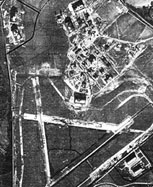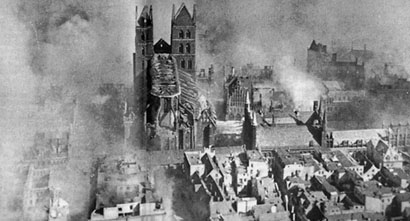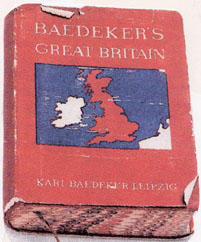Why Was Bath Blitzed
Bath was not expected to be a particular target for German bombers.
The residents expected a few stray bombs now and again, but did not expect intense bombing. The Government thought Bath was relatively safe, so much so that Bath was a destination for evacuees and Government Departments transferred from London. Indeed, Bath was not provided with anti-aircraft defences because an attack was considered unlikely.
What the Germans knew about Bath
The German Army had a pre-war British six-inch Ordnance Survey map of Bath, which they over-printed in various colours to mark the principal industrial, civic and medical facilities in the city, which would be important objectives in the event of an invasion.
The German Air Force however relied more on photo-reconnaissance. During the second half of 1940 at least eleven reconnaissance aircraft flying from French airfields are known to have operated over Bath.
 The Junkers Ju 88 (like the one pictured) which flew over the area on August 30th probably took the photograph which showed for the first time the location of the Admiralty buildings at Fox Hill. Later flights identified the military hutments at Lansdown (Ensleigh), and also, to the north east of Bath, Charmy Down airfield, which at that time was still under construction.
The Junkers Ju 88 (like the one pictured) which flew over the area on August 30th probably took the photograph which showed for the first time the location of the Admiralty buildings at Fox Hill. Later flights identified the military hutments at Lansdown (Ensleigh), and also, to the north east of Bath, Charmy Down airfield, which at that time was still under construction.
 The Germans were already aware of the RAF Maintenance Unit at Colerne, laid out in late 1939, but when they took another aerial photograph on November 30th 1940 (see picture), the film showed the presence of specially constructed runways, indicating its new role as an operational airfield.
The Germans were already aware of the RAF Maintenance Unit at Colerne, laid out in late 1939, but when they took another aerial photograph on November 30th 1940 (see picture), the film showed the presence of specially constructed runways, indicating its new role as an operational airfield.
Germany was aware of a military presence in the city, but they believed it was "High Staff Officers of the British Defensive forces who have set up their headquarters in the hotels and bungalows of Bath". There was an element of truth in that, but it very much understated the real situation.
The Germans never seem to have established the real purpose of hutments at Fox Hill and Lansdown, so as far as they were concerned, Bath was not really worth attacking.
What the Germans didn't know about Bath
Bath was home to a number of undertakings important enough to be considered by the Ministry of Home Security as 'Key Points'.
These included:
- Stothert & Pitt's Victoria and Newark works where gun mountings for tanks, human torpedoes, and minesweeping gear were manufactured;
- The Newbridge and Albion plants of the Horstmann Gear Company which concentrated on the production of fire control instruments and torpedo parts;
- The British Overseas Airways Corporation, occupying Bath Garages in James Street West, and Isaac Pitman's in the Lower Bristol Road, both of which were used for the overhaul of aircraft propellers;
- Bath Aircraft, also in the Lower Bristol Road, making such things as wooden parts for assault gliders.
Also, the Admiralty, evacuated westwards at the outbreak of war, had taken over more than twenty-five buildings in the city and had built the Fox Hill and Lansdown camps.
Clearly, the Germans had underestimated Bath's contribution to the British war effort.
The real reason
In the last half of 1941, Germany decided to attack Russia. To support such an attack, it is necessary to collect together all the supplies and equipment that will be needed.
 A lot of stores were moved to ports in northern Germany, on the Baltic Sea coast, so that the Russian Front could be supported by supplies brought by sea.
A lot of stores were moved to ports in northern Germany, on the Baltic Sea coast, so that the Russian Front could be supported by supplies brought by sea.
Britain knew which cities were holding these supplies: Lübeck and Rostock. Britain could help the Russians by destroying the German supplies by bombing them.
But because Britain did not know where in the towns the supplies were being stored, a wide area of Lübeck was bombed. (This picture is a reconnaissance photograph of Lübeck after the bombing.)
A single air raid took place on Saturday 28th March 1942.
 On Thursday 23rd April 1942, Rostock was bombed for the first time. Rostock had industrial targets too, including a shipyard making submarines and a factory making Heinkel aircraft parts, so the British bombers went back the following three days as well.
On Thursday 23rd April 1942, Rostock was bombed for the first time. Rostock had industrial targets too, including a shipyard making submarines and a factory making Heinkel aircraft parts, so the British bombers went back the following three days as well.
Lübeck and Rostock were both beautiful heritage cities with many old buildings, some over 500 years old. The bombing destroyed much of these historic cities. (This picture is of a Heinkel He 111H bomber which the factory was making parts for.)
In revenge, Germany bombed a number of beautiful English cities that were also famous for their heritage: Bath, Canterbury, Exeter, Norwich and York.
(These were all night raids. Some of the bombing would have been in the early hours of the following mornings)
| CITY | DATES BOMBED |
| Bath | Saturday 25th April 1942 Sunday 26th April 1942 |
| Canterbury | Sunday 31st May 1942 Tuesday 2nd June 1942 Saturday 6th June 1942 |
| Exeter | Thursday 23rd April 1942 Friday 24th April 1942 Sunday 3rd May 1942 |
| Norwich | Monday 27th April 1942 Wednesday 29th April 1942 |
| York | Tuesday 28th April 1942 |
These bombing raids have been nicknamed "The Baedeker Raids".
 Before the war, an author named Karl Baedeker produced "Baedeker's Guides" to various countries which identified areas of special interest to tourists. All of these cities were recommended for their architecture in "Baedeker's Guide to Britain". The entry for Bath in the 1937 edition read:
Before the war, an author named Karl Baedeker produced "Baedeker's Guides" to various countries which identified areas of special interest to tourists. All of these cities were recommended for their architecture in "Baedeker's Guide to Britain". The entry for Bath in the 1937 edition read:
"Bath, the chief winter spa in Britain is a handsome city of 68,000 inhabitants, with a mild and sedative climate, beautifully situated in the sheltered valley of the Avon and on the slopes of the surrounding hills, and is unrivalled among provincial English towns for its combination of archaeological, historic, scenic and social interest. It is a city of crescents and terraces, built in a substantial Palladian style of 'Bath Stone', and rising tier above tier to a height of about 6000 feet. Bath owes its external appearance very largely to the architect John Wood and his son of the same name who set the style of architecture that others followed, and Bath is an admirable specimen of 18th century town planning".
It is not known for certain whether "Baedeker's Guides" were actually used to identify the targets though.
THE NEW BOOK OF KNOWLEDGE, published by Waverley just after the war, has just two paragraphs on the Baedeker raids:
Baedeker Raids. These night raids on Britain historical cities starred in Baedeker's Guides as of special interest to tourists, took place in April-June 1942. The Germans justified this bombing of non-military objectives on the grounds that the R.A.F. had done likewise in bombing the ancient German Hansa cities, omitting to mention that these were also reinforcing bases for the Russian front.
Exeter had "reprisal" raids on April 24-25 and May 3, when many old buildings including the cathedral were damaged. Norwich sustained heavy damage April 27-28 and 29-30. In the second "Baedeker" raid on Bath, April 26-27, the famous Assembly Rooms and five churches were wrecked. On the night of April 28-29, York's Gothic Guildhall was burnt out; Canterbury Cathedral Library was completely wrecked May 31-June 1, in reprisal for the RAF 1,000 bomber raid on Cologne of the previous night.
War Office and Luftwaffe Archives
A local historian, John Penny, researched the RAF records and the Luftwaffe records that survived the war, and prepared a very detailed analysis of exactly what happened leading up to the Bath Blitz.
Also, at the end of each section of this website covering the actual raids, will be a link to his research into that raid.
If you can't find where you want to go next using the navigation buttons at the top of this page, this button will take you to the page containing the complete site index.
